
Understanding the Skills Gap
Identifying the Current Challenges in Workforce Capabilities
The modern workforce is evolving rapidly, and with this evolution comes the inevitable skills gap that many organizations face today. This disparity between the skills that employees possess and the skills that the company requires can have significant impacts on productivity, innovation, and growth. With the acceleration of technology and changing market demands, many industries are finding it increasingly difficult to keep pace without continuous employee development. Understanding this gap is crucial for developing a successful mentorship program. It allows organizations to tailor their initiatives to bridge these differences effectively. Employees often lack specific technical or soft skills that are essential for their roles. Without proper intervention and ongoing learning development, this misalignment could hamper the overall goals of the organization. Some main challenges related to the skills gap include:- Rapid Technological Advancements: As technology develops, the skills required to work with new tools and platforms also change, resulting in a gap between existing skills and new requirements.
- Evolving Market Needs: Shifts in consumer behavior and market trends can render current skills obsolete, necessitating urgent upgrading of employee capabilities.
- Lack of Access to Training: Employees might not have sufficient time or resources to engage in professional development, further exacerbating the gap.
The Role of Mentorship in Bridging the Gap
Mentorship as a Catalyst for Skill Enhancement
Mentoring programs hold immense potential in addressing the challenges of the existing skills gap prevalent in many industries. Such programs have a dual role: nurturing both the growth of mentees and the development of mentors. When structured effectively, these initiatives guide participants toward achieving their professional development goals while enhancing vital skills. Mentors and mentees can engage in a reciprocal exchange of knowledge and practical experiences, fostering a mutually beneficial relationship. Mentors, often equipped with years of expertise, contribute invaluable insights which help mentees navigate their career paths and address skills deficiencies. This knowledge transfer is crucial for the long-term success of any organization. Moreover, mentoring programs can offer more than just immediate skills enhancement. As mentees learn and adapt, they also contribute fresh perspectives that may inspire mentors to re-evaluate certain practices or embrace new methodologies. This collective learning promotes an environment conducive to both individual and organizational development. To ensure the success of such programs, organizations should focus on matching mentors and mentees based on complementary skills and objectives, aligning with the overall program goals. Adopting best practices—such as utilizing mentoring software to manage and track progress—can enhance the effectiveness of these interactions, leading to a successful mentorship experience for all parties involved. Enhancing leadership skills is an essential component of any productive mentoring relationship. This aspect is especially important for mentors in leadership roles. By participating in mentorship programs, mentors refine their coaching abilities and reinforce their leadership capabilities, ultimately contributing to a culture of continuous learning and development within the organization.Key Components of a Mentorship Program Template
Essential Elements for a Structured Learning Experience
Creating a mentorship program template involves identifying the key components that will foster effective mentor-mentee relationships and drive professional development. The success of your initiatives often stems from well-thought-out templates that guide the programs. Here, we'll explore vital aspects that contribute to building a successful mentorship structure.
- Clear Program Goals: Define specific objectives for the mentoring program to ensure that both mentors and mentees are aligned in their efforts. Whether it's enhancing learning development or promoting long-term employee growth, clear goals provide direction and purpose.
- Effective Matching Criteria: Matching mentors and mentees based on their professional backgrounds, interests, and skills can foster more meaningful and productive relationships. Successful mentorship often depends on how well the participants are paired.
- Structured Communication: Establish guidelines for how and when mentors and mentees will interact. Regular check-ins and consistent communication are key to developing a strong mentoring bond and achieving set goals.
- Development Plans: Craft personalized development plans that outline specific learning objectives, time frames, and milestones. These plans help mentees navigate their career paths and set realistic, achievable targets.
- Continuous Support: Implement ongoing support mechanisms such as mentoring software or a mentoring committee to address any challenges mentors or mentees might face. This ensures continuous improvement and adaptation of the program to meet changing needs.
- Evaluation and Feedback: Regularly assess the program's effectiveness through feedback from mentors and mentees. This evaluation will highlight areas of success and opportunities for adjustment to improve the program over time.
- Resource Accessibility: Providing access to resources like learning materials, courses, and social media platforms can enhance the mentees' learning journey and ensure a comprehensive development experience.
By integrating these components, you establish a robust foundation that supports successful mentoring relationships. This strategic organization helps bridge the skills gap, enabling participants to achieve personal and professional growth. To further understand the importance of development programs in closing skills gaps, you might find insights by mastering the executive assessment test useful.
Designing a Tailored Mentorship Program
Creating a Customized Blueprint for Mentorship
Designing a tailored mentorship program is a crucial step for organizations aiming to bridge the skills gap within their workforce by focusing on professional development. This not only involves aligning the program with organizational goals but also tailoring it to the unique needs of the mentees and mentors involved. One of the key elements in crafting an effective mentorship program is to establish clear program goals. These goals will guide the development of the mentorship framework and ensure that both the mentors and mentees understand the objectives. Whether it is improving specific skills, enhancing employee engagement, or fostering leadership development, clear goals provide a roadmap for success. Next, consider the structure of the mentorship program. This includes deciding on the format, frequency, and duration of mentoring sessions. Programs can be structured in various ways, such as one-on-one mentorships, group mentoring, or even peer mentoring. The best approach depends largely on the organization’s culture and the participants' preferences.Building Effective Matching Systems
A successful mentor-mentee relationship hinges on the proper matching of participants. Developing matching criteria is essential to foster meaningful connections that promote learning and skills development. Factors to consider include professional interests, career goals, and interpersonal compatibility. Some organizations are now leveraging mentoring software to automate and enhance the matching process, ensuring that it is as precise and efficient as possible.Encouraging Continuous Engagement
To maintain momentum and engagement over time, it is important to integrate continuous learning opportunities into the program. Encourage mentors and mentees to regularly communicate and set both short-term and long-term goals. This ongoing dialogue can be facilitated by incorporating feedback mechanisms into the program structure, aiding continuous improvement and adaptation. Learning from other successful mentorship programs can provide valuable lessons and best practices. Consider creating a mentoring committee dedicated to overseeing the program’s operation and ensuring its alignment with company objectives. Additionally, engaging with social media can enhance visibility and encourage broader participation, promoting a culture of mentorship within the organization. By carefully designing and tailoring a mentorship program, organizations can effectively bridge the skills gap, resulting in a more competent and prepared workforce. This targeted approach allows for personal growth and achievement, benefiting both the participants and the enterprise as a whole.Implementing and Managing the Program
Implementing the Mentorship Framework
Implementing an effective mentoring program involves systematic and dynamic processes to ensure its success. For any organization, the strategic roll-out and management of their mentorship initiatives can be pivotal in achieving the program goals and addressing the skills gap challenge. Here, we explore how to execute and oversee this framework effectively while maximizing professional development for both mentors and mentees. A successful mentorship program requires a well-planned structure. Begin by aligning the program with the organization’s learning development objectives. This involves ensuring that mentors and mentees are adequately prepared and aware of the expected outcomes. It’s important to inform all participants about the program’s objectives and the skills areas that need development. To achieve optimal mentor-mentee match-ups, applying thoughtful matching criteria is essential. These criteria may include aligning the mentor's expertise with the mentee's professional development needs or ensuring complementary communication styles. Many organizations find success using mentoring software to facilitate this matching process efficiently. Consider establishing a mentoring committee to oversee program management, ensuring its alignment with best practices. This committee can play a role in guiding the program’s objectives, tracking progress, and making any necessary adjustments to the program template. Time management is another crucial aspect. Ensure that both mentors and mentees allocate adequate time for their interactions. Setting a consistent schedule for mentoring sessions can help maintain momentum and foster sustained engagement. To support learning and development holistically, encourage participants to utilize multiple platforms, including social media, for sharing insights and experiences. This helps create a community around the mentorship initiative, where mentors and mentees can learn from and inspire each other beyond meetings. Ultimately, the key to a successful mentorship program lies in continuous oversight and adaptability. Regularly collecting feedback from mentors, mentees, and the committee is invaluable for identifying areas that require improvement. This proactive approach ensures the program remains relevant and impactful in bridging the skills gap for employees over the long term.Measuring Success and Continuous Improvement
Evaluating Program Effectiveness and Driving Growth
After implementing a mentorship program, it's critical to assess its success and identify areas for improvement. Here's a guide to help you evaluate and continuously enhance your program:- Set Clear Metrics and Goals: Begin by defining what success looks like for your mentorship program. Consider metrics such as employee engagement, skill development, and mentors mentees satisfaction. Clear goals will guide the evaluation process and measure the program's impact on professional development.
- Regular Feedback Collection: Create channels for mentors and mentees to provide feedback regularly. Surveys, one-on-one interviews, and focus groups can unveil insights into the program's strengths and challenges. Structured feedback sessions foster an environment of continuous learning and development.
- Analyzing Matching Criteria: Evaluate if the matching process effectively pairs mentors with mentees. Ensure that the criteria used, such as skills and goals alignment, remain relevant and effective in fostering productive mentorship relationships.
- Utilize Mentoring Software: Technology can play a vital role in tracking mentorship program success. Use software solutions to monitor progress, keep track of mentee milestones, and generate reports that highlight areas for improvement.
- Role of a Mentoring Committee: Form a mentoring committee tasked with program oversight. This team can analyze program data, address concerns, and ensure the program aligns with organizational goals. A dedicated committee helps maintain the structure and effectiveness of your mentorship program.
- Support Long-Term Growth: Encourage mentors to focus on long-term development rather than short-term fixes. This approach helps sustain skills development and better prepares employees for future roles within the organization.












